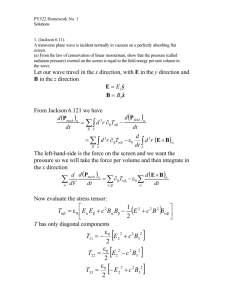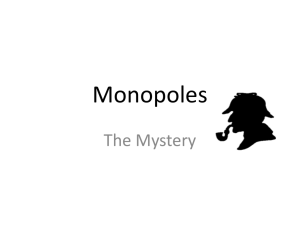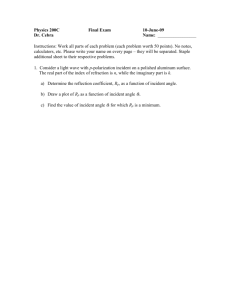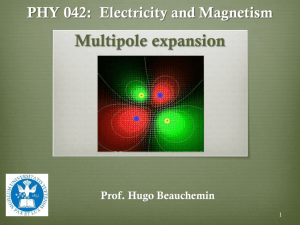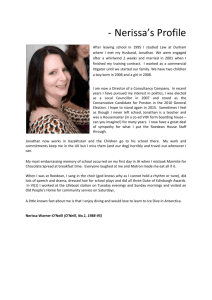The monopole category and invariants of bordered 3-manifolds Jonathan Bloom
advertisement
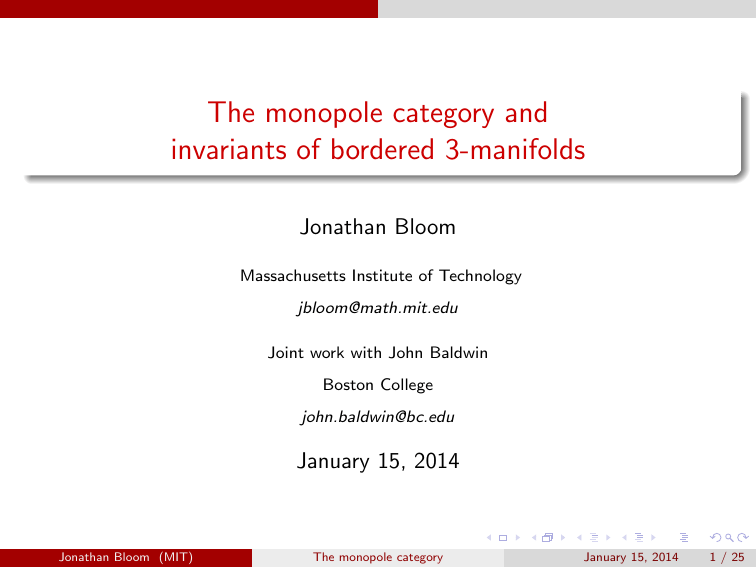
The monopole category and
invariants of bordered 3-manifolds
Jonathan Bloom
Massachusetts Institute of Technology
jbloom@math.mit.edu
Joint work with John Baldwin
Boston College
john.baldwin@bc.edu
January 15, 2014
Jonathan Bloom (MIT)
The monopole category
January 15, 2014
1 / 25
Overview
1
Khovanov’s arc algebra
2
Monopole category
3
Finite generation
4
Monopole algebra
Jonathan Bloom (MIT)
The monopole category
January 15, 2014
2 / 25
Khovanov’s arc algebra
Khovanov’s arc algebra
Jonathan Bloom (MIT)
The monopole category
January 15, 2014
3 / 25
Khovanov’s arc algebra
Khovanov homology
LinkCob is the category of links in S 3 and link cobordisms in S 3 × [0, 1].
Khovanov defines a functor F : LinkCob → Vect.
F(L) is the reduced Khovanov homology of L with coefficients in F2 .
Let V be a rank-2 vector space over F2 . For the k-component unlink,
F( · · · ) = Λk−1 V
In particular, F() = F2 and F() = V .
Jonathan Bloom (MIT)
The monopole category
January 15, 2014
4 / 25
Khovanov’s arc algebra
Crossingless matchings
Let B n be the set of crossingless matchings on 2n points.
Let b̄ denote the reflection of b across the x-axis.
Then a ∪ b̄ is a planar unlink and we have well-defined link cobordisms
Sa,b,c : (a ∪ b̄) t (b ∪ c̄) → a ∪ c̄
Jonathan Bloom (MIT)
The monopole category
January 15, 2014
5 / 25
Khovanov’s arc algebra
The arc algebra H n
Khovanov defines the ring
Hn =
M
F(a ∪ b̄).
a,b∈B n
The product of x ∈ F(a ∪ b̄) and y ∈ F(b ∪ c̄) is given by the map
F(Sa,b,c ) : F(a ∪ b̄) ⊗ F(b ∪ c̄) → F(a ∪ c̄)
To a tangle T on 2n points, he associates a right H n -module
M
F(T ) =
F(T ∪ b̄).
b∈B n
The action of H n is defined as above using F(ST ,b,c ).
To a cobordism of tangles, he associates a module homomorphism.
Jonathan Bloom (MIT)
The monopole category
January 15, 2014
6 / 25
Khovanov’s arc algebra
Pairing theorem
These structures turn F into a 2-functor from points, tangles, and tangle
cobordisms to algebras, bimodules, and bimodule homomorphisms.
For example, there is a pairing theorem for tangles on 2n points:
F(T0 ) ⊗H n F(T̄1 ) ∼
= F(T0 ∪ T̄1 )
The proof uses the skein relation to reduce to the case where T0 and T1
are crossingless matchings, and from there to H n ⊗H n H n ∼
= H n.
F(L) = cone (F(S) : F(L0 ) → F(L1 ))
Jonathan Bloom (MIT)
The monopole category
January 15, 2014
7 / 25
Khovanov’s arc algebra
Another view of Sa,b,c
Jonathan Bloom (MIT)
The monopole category
January 15, 2014
8 / 25
Monopole category
The monopole category
Jonathan Bloom (MIT)
The monopole category
January 15, 2014
9 / 25
Monopole category
The monopole category C(Σ)
Let Σ be a smooth, connected, oriented surface of genus g .
A bordered 3-manifold over Σ is a smooth, connected, oriented 3-manifold
Y together with an orientation-preserving diffeomorphism ϕ : ∂Y → Σ.
We now define the monopole category C(Σ) of Σ. an A∞ category.
The objects of C(Σ) are all bordered 3-manifolds over Σ.
Mor(Y0 , Y1 ) is given by the monopole Floer chain complex Ĉ (Y0 ∪Σ Ȳ1 ).
For each k > 0 and sequence Y0 , . . . , Yk , there is a multiplication map
µk : Ĉ (Y0 ∪Σ Ȳ1 ) ⊗ · · · ⊗ Ĉ (Yk−1 ∪Σ Ȳk ) → Ĉ (Y0 ∪Σ Ȳk )
and these maps satisfy the A∞ relations.
Jonathan Bloom (MIT)
The monopole category
January 15, 2014
10 / 25
Monopole category
Context
Our construction is modeled on the Morse category of a manifold, which is
also the basis for the Fukaya category of a symplectic manifold.
Conjecture: Fuk(Symg (Σ)) and C(Σ) are A∞ equivalent via a map sending
the Lagrangian Tα ⊂ Symg (Σ) to the bordered handlebody (Σ, α).
This is a strengthening of HF ∼
= HM, itself an analogue of Atiyah-Floer.
Lipshitz-Ozsváth-Thurston, Lekili-Perutz, Mau-Wehrheim-Woodward
Jonathan Bloom (MIT)
The monopole category
January 15, 2014
11 / 25
Monopole category
Multiplication maps µk
For objects Y0 , · · · , Yk , the multiplication map
µk : Ĉ (Y0 ∪Σ Ȳ1 ) ⊗ · · · ⊗ Ĉ (Yk−1 ∪Σ Ȳk ) → Ĉ (Y0 ∪Σ Ȳk )
is defined by counting monopoles on a 4-dimensional cobordism WY0 ,··· ,Yk
over a family of metrics and perturbations parameterized by the k − 2
dimensional associahedron (point, interval, pentagon,...).
e2
4
e0
e3
Σ×4
Y2 ∪ −Y3
e1
Y0 ∪ −Y1
Y1 ∪ −Y2
Y0 ∪ −Y3
Jonathan Bloom (MIT)
The monopole category
January 15, 2014
12 / 25
Monopole category
Higraph model of µ3 .
Jonathan Bloom (MIT)
The monopole category
January 15, 2014
13 / 25
Monopole category
The first three A∞ relations.
Jonathan Bloom (MIT)
The monopole category
January 15, 2014
14 / 25
Monopole category
Challenge: reducibles
Kronheimer and Mrowka model monopole Floer theory on Morse theory
for a manifold with boundary.
[B] The combinatorics of Morse homology with boundary.
http://arxiv.org/pdf/1212.6467v1.pdf
Jonathan Bloom (MIT)
The monopole category
January 15, 2014
15 / 25
Monopole category
Challenge: coherent data
To define C(Σ), we must make many choices (diffeomorphisms, metrics,
perturbations,...) such that the A∞ relations hold on the nose. Parallel
issues arise for the Fukaya category. In our case, C(Σ) is also well-defined
up to A∞ equivalence, and we are working to make this ‘natural’.
Our approach to coherence is novel and hinges on Smale’s 1964 result that
Diff(D 2 , ∂D 2 ) is contractible. In fact, we need a diffeologically smooth
version of this fact that first appeared in 2011.
Jiayong Li and Jordan Alan Watts. The orientation-preserving
diffeomorphism group of S 3 deforms to SO(3) smoothly. Transformation
Groups, Springer, Vol. 16, No. 2, 2011, pp. 537-553.
Jonathan Bloom (MIT)
The monopole category
January 15, 2014
16 / 25
Finite generation
Finite generation
Jonathan Bloom (MIT)
The monopole category
January 15, 2014
17 / 25
Finite generation
A surgery triad is a triple of 3-manifolds (Y , Y0 , Y1 ) such that there is a
framed knot K in Y such that Yi is i-surgery on K .
Significance: Floer homology sends surgery triads to exact triangles.
Ĉ (Y ) ∼
cone
m̂(W
)
:
Ĉ
(Y
)
→
Ĉ
(Y
)
=
0
1
Ex: (S 3 , S 1 × S 2 , S 3 ) forms a surgery triad via surgery on the unknot.
Ex: (#k−1 S 1 × S 2 , #k S 1 × S 2 , #k−1 S 1 × S 2 ) is a surgery triad.
We say that the 3-manifolds #k S 1 xS 2 are generated by S 3 through
surgery triads.
All branched-double covers are generated by S 3 because the skein triangle
corresponds to the surgery triad under branched double cover.
In fact, all closed 3-manifolds are generated by S 3 through surgery triads.
Jonathan Bloom (MIT)
The monopole category
January 15, 2014
18 / 25
Finite generation
Skein triangle below
Jonathan Bloom (MIT)
The monopole category
January 15, 2014
19 / 25
Finite generation
Surgery triangle above
Jonathan Bloom (MIT)
The monopole category
January 15, 2014
20 / 25
Finite generation
Bordered manifolds
Bordered manifolds that arise as branched covers of T ⊂ D 3 on 2g + 2
points are generated by branched covers of the cg crossingless matchings.
With this motivation, we’ve shown that all bordered manifolds over Σg are
generated by ng bordered handlebodies:
n1 = 1,
ng = 1 +
g
−1
X
ni ng −i
i=1
This also equals the binomial transform of the Catalan numbers cg .
g X
g
ng =
cg
k
k=0
cg +1 = 1, 1, 2, 5, 14, 42, 132, 429, 1430, 4862, ...
ng =
1, 2, 5, 15, 51, 188, 731, 2950, 12235, ...
Conjecture: ng is minimal.
Jonathan Bloom (MIT)
The monopole category
January 15, 2014
21 / 25
Finite generation
Coincidence?
Khovanov’s generators count vertices of the associahedron.
Our bordered generators count vertices of the composihedron.
Stefan Forcey, Quotients of the multiplihedron as categorified associahedra, Homotopy,
Homology and Applications, vol. 10(2), 227256, 2008.
Jonathan Bloom (MIT)
The monopole category
January 15, 2014
22 / 25
Monopole algebra
The monopole algebra
Jonathan Bloom (MIT)
The monopole category
January 15, 2014
23 / 25
Monopole algebra
The monopole algebra
Now that we have a set H(Σ) = {Hα } of finitely many generators for
C(Σ), we can equivalently work with A∞ algebras and modules:
M
M
A(Σ) =
F(Hα ∪Σ H̄β )
C(Y ) =
F(Y ∪Σ H̄β )
α,β
β
Here C(Y ) is an invariant of the bordered manifold Y up to
quasi-isomorphism, and the pairing theorem holds by reduction to
Khovanov’s approach.
MCG(Σ) acts on A(Σ) and in fact yields a faithful linear-categorical
action in every genus except possibly g = 2 (here we rely on recent work
of Corrin Clarkson and HM = HF).
We can compute the homology algebra of A(Σ) explicitly. It naturally
contains a copy of the arc algebra H g +1 .
Jonathan Bloom (MIT)
The monopole category
January 15, 2014
24 / 25
Monopole algebra
2+1+1
HM is a “2-functor” from the “2-category” of surfaces, cobordisms of
surfaces, and cobordisms of cobordisms of surfaces to the “2-category” of
A∞ algebras, bimodules, and maps of bimodules.
A cobordism of surfaces with n boundary components yields an A∞
n-module.
Master version may have applications to computing 4-manifold invariants.
Topological approach goes through in other Floer theories and may give
algebraic insight into equivalences.
d Σ YΣ )
(Optimistic) conjecture: HH(A(Σ) C (Y )A(Σ) ) ,→ HM(∪
Jonathan Bloom (MIT)
The monopole category
January 15, 2014
25 / 25
